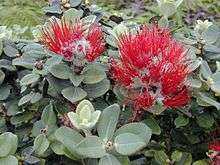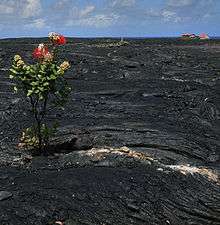Metrosideros polymorpha
| ʻŌhiʻa lehua | |
|---|---|
 | |
| ʻŌhiʻa lehua flowers | |
| Scientific classification | |
| Kingdom: | Plantae |
| Clade: | Angiosperms |
| Clade: | Eudicots |
| Clade: | Rosids |
| Order: | Myrtales |
| Family: | Myrtaceae |
| Genus: | Metrosideros |
| Species: | M. polymorpha |
| Binomial name | |
| Metrosideros polymorpha | |
| Varieties | |
|
M. p. var. dieteri | |
| Synonyms[2] | |
|
List
| |
Metrosideros polymorpha, the ʻōhiʻa lehua,[3] is a species of flowering evergreen tree in the myrtle family, Myrtaceae, that is endemic to the six largest islands of Hawaiʻi. It is a highly variable tree, being 20–25 m (66–82 ft) tall in favorable situations, and a much smaller prostrate shrub when growing in boggy soils or directly on basalt. It produces a brilliant display of flowers, made up of a mass of stamens, which can range from fiery red to yellow. Many native Hawaiian traditions refer to the tree and the forests it forms as sacred to Pele, the volcano goddess, and to Laka, the goddess of hula. ʻŌhiʻa trees grow easily on lava, and are usually the very first plants to grow on new lava flows.
It is a common misconception that the word ʻōhiʻa is used to refer to the tree and that the word lehua refers only to its flowers. The Hawaiian Dictionary (Pukui and Elbert 1986: 199) defines lehua with these words: "The flower of the ʻōhiʻa tree... also the tree itself [emphasis added]." Thus the Metrosideros polymorpha may be referred to correctly as a lehua tree, or as an ʻōhiʻa lehua, or simply an ʻōhiʻa.[4][5]
Distribution
Metrosideros polymorpha is the most common native tree in the Hawaiian Islands, tolerating a wide range of soil conditions, temperature, and rainfall. It grows from sea level right up to the tree line at elevations of 2,500 m (8,200 ft) and is commonly found in moist and dry forests, high shrublands, and is a colonizer of recent lava flows. It is relatively slow growing. Dominant in cloud forests above 400 m (1,300 ft), the tree is also common in seasonally wet forests, where it may be dominant or form mixtures with the native Acacia koa.
Habitat
.jpg)
Metrosideros polymorpha may occur as a tall tree or a prostrate shrub, and everything in between. Preferred soils are acidic to neutral (pH 3.6-7.4) and either a Histosol, Mollisol, Podsol, Oxisol, Ultisol, or Alfisol. Rainfall of 1,000–3,000 mm (39–118 in) per year is favored, but ʻōhiʻa can grow in dry forests that receive as little as 400 mm (16 in) or bogs that get more than 10,000 mm (390 in) of rain.[1] On moist, deep soils, ʻōhiʻa grows to 20–25 m (66–82 ft) high. Specimens reaching 30 m (98 ft) high are on record. The trunk varies in form. In some trees, it is straight and smooth; in others, it is twisted and prominently fluted. Trees growing in forests often have stilt roots, having germinated on logs or the stems of fallen hāpuʻu (Cibotium tree ferns), which have long decayed away when the tree has reached maturity. Some trees have fibrous aerial roots to gather moisture. At high elevations, and in areas with poor soils or little rainfall, shrub forms are the norm. Flowers are usually bright to medium red but orange-red, salmon, pink, yellow, or orange forms are also found. The flowers appear in clusters on the terminal ends of the branches. Masses of stamens extend from the flower and give the blossoms their characteristic pom-pom shape.
Uses

The reddish brown heartwood of M. polymorpha is very hard, fine textured, and has a specific gravity of 0.7.[6] In native Hawaiian society, it was used in house and heiau construction, as well as to make papa kuʻi ʻai (poi boards), weapons, tool handles, hohoa (round kapa beaters), and kiʻi (statues and idols).[7] Although the trunk of ʻōhiʻa was not used to make the kaʻele (hull) of waʻa (outrigger canoes), it was used for their nohona waʻa (seats), pale (gunwales), and pola (decking). Wae (spreaders) were made from the curved stilt roots of ʻōhiʻa. Pā (fencing) was made from the wood due to its availability; kauila (Colubrina oppositifolia or Alphitonia ponderosa), more durable woods when in contact with soil, was rarer. As the wood burned hot and cleanly, it was excellent wahie (firewood). The lehua (flowers) and liko lehua (leaf buds) were used in making lei.[1] The flowers were used medicinally to treat pain experienced during childbirth.[8]
ʻŌhiʻa lehua is one of the few honey plants that is native to the Hawaiian Islands.[1][9]
Similar species
There are about 50 species in the genus Metrosideros in Southeast Asia and the Pacific and as well one species in South Africa. The Hawaiian Islands are home to five species of Metrosideros that are endemic to the islands, meaning they are found nowhere else in the world. These are: Metrosideros polymorpha,M. macropus, M. rugosa, M. tremuloides, and M. waialealae. The species are readily distinguished from one another by the characteristics of their leaves.[10]
Metrosideros kermadecensis, from the Kermadec Islands north of New Zealand, has recently become naturalized on Maui and may become a pest species. Several cultivars of M. excelsa, the Pōhutukawa tree of New Zealand, have been sometimes planted as ornamentals in Hawaiʻi but are not reported to have naturalized. Metrosideros polymorpha was originally classified as a variety of M. collina, native to Rarotonga, Tahiti, and other islands of Polynesia, but now is generally accepted as a distinct Hawaiian endemic species.
Conservation

Metrosideros polymorpha forests in Hawaiʻi have been invaded by myriad alien species. In the wet forests these include the strawberry guava (Psidium littorale), albizia (Falcataria moluccana), and "purple plague" (Miconia calvescens). In drier areas, problematic invaders include faya tree (Myrica faya) and Christmasberry (Schinus terebinthifolius). Alien grasses such as meadow ricegrass (Ehrharta stipoides) may form an understory that prevents or inhibits natural regeneration of the forests. In drier areas, M. polymorpha has to compete with silk oak (Grevillea robusta) and fountain grass (Pennisetum setaceum).
Rapid 'Ōhi'a Death
More recently, a strain of fungus initially identified as Ceratocystis fimbriata has attacked the ʻōhiʻa forests of the Big Island, causing Rapid 'Ōhi'a Death. While ʻōhiʻa itself remains extremely abundant, some species that depend on it such as the ʻakekeʻe (Loxops caeruleirostris) and longhorn beetles in the genus Plagithmysus have become endangered due to shrinkage of forest areas. In April 2018, the cause of Rapid 'Ohi'a Death was identified as two species of Ceratocystis previously unknown to science: C. huliohia and C. lukuohia.[11] By May 2018, infected ʻōhiʻa trees were found on the island of Kauai, prompting requests that members of the public limit transportation of ʻōhiʻa products within the island.[12]
Etymology
The genus name Metrosideros is derived from the Greek words metra, meaning 'heartwood', and sideron, meaning 'iron', and refers to the hard wood of the trees in this genus. The specific epithet polymorpha, meaning 'many forms', is very appropriate, since individuals of this species exhibit many different morphologies and inhabit a broad range of ecological situations.[13] The Hawaiian language word ʻōhiʻa is thought to have been derived from the ancestral Proto-Oceanic word, *kafika.[14][15] Throughout Oceania, there are many similar-sounding words that were also derived from the same ancestral protoform and, in most cases, they are names for the "mountain apple", or "Malay apple" tree, Syzygium malaccense. In the Hawaiian Islands, however, the word ʻōhiʻa is not only used to refer to Syzygium malaccense, but also to other species of Syzygium and Metrosideros that occur there.[16] The derivation of the word lehua is more obscure, and while there are many opinions regarding its origin, there has been to date, no historical linguistic study of the word to provide convincing evidence for any particular etymology.
Mythology
In Hawaiian mythology, ʻŌhiʻa and Lehua were two young lovers. The volcano goddess Pele fell in love with the handsome ʻŌhiʻa and approached him, but he turned down her advances. In a fit of jealousy, Pele transformed ʻŌhiʻa into a tree. Lehua was devastated by this transformation and out of pity the other gods turned her into a flower and placed her upon the ʻōhiʻa tree.[17] Other versions say that Pele felt remorseful but was unable to reverse the change, so she turned Lehua into a flower herself.[18] It is said that when a lehua flower is plucked from an ʻōhiʻa tree, the sky will fill with rain representing the separated lovers' tears.
Notes
- 1 2 3 4 Friday, J. B.; Darrell A. Herbert (April 2006). "Metrosideros polymorpha (ʻōhiʻa lehua)" (PDF). The Traditional Tree Initiative.
- ↑ "World Checklist of Selected Plant Families".
- ↑ Mary Kawena Pukui and Samuel Hoyt Elbert (2003). "lookup of ʻōhiʻa". in Hawaiian Dictionary. Ulukau, the Hawaiian Electronic Library, University of Hawaii Press. ; Mary Kawena Pukui and Samuel Hoyt Elbert (2003). "lookup of lehua". in Hawaiian Dictionary. Ulukau, the Hawaiian Electronic Library, University of Hawaii Press.
- ↑ Wagner, W.L., D.R. Herbst and S.H. Sohmer. 1999. Manual of the Flowering Plants of Hawaiʻi. Bishop Museum Special Publication 97, University of Hawaiʻi Press, Honolulu.
- ↑ Pukui, M.K. and S.H. Elbert. 1986. Hawaiian Dictionary. University of Hawaii Press, Honolulu.
- ↑ Allen, James A. (2003-01-01). "Metrosideros polymorpha Gaudich" (PDF). Reforestation, Nurseries and Genetics Resources. Archived from the original on 2012-05-19. Retrieved 2013-02-11.
- ↑ Medeiros, A. C.; C.F. Davenport; C.G. Chimera (1998). "Auwahi: Ethnobotany of a Hawaiian Dryland Forest" (PDF). Cooperative National Park Resources Studies Unit, University of Hawaiʻi at Mānoa.
- ↑ "ohia lehua, lehua, ohia". Hawaiian Ethnobotany Online Database. Bernice P. Bishop Museum. Retrieved 2009-02-23.
- ↑ Roddy, Kevin M.; Lorna Arita-Tsutsumi (1997). "A History of Honeybees in the Hawaiian Islands" (PDF). Journal of Hawaiian and Pacific Agriculture. 8: 61.
- ↑ Wagner et al. 1999: 965.
- ↑ "Two new species of fungi that kill ʻōhiʻa trees get Hawaiian names". University of Hawaiʻi System News. 2018-04-17. Retrieved 2018-05-14.
- ↑ Bernardo, Rosemarie (2018-05-11). "Ohia fungus found on Kauai". Honolulu Star-Advertiser. Retrieved 2018-05-14.
- ↑ Wagner et al. 1999: 967
- ↑ Polynesian Lexicon Project Online, entry *kafika
- ↑ See POLLEX
- ↑ Wagner et al. 1999: 964-976
- ↑ "{title}". Archived from the original on 2009-06-09. Retrieved 2009-07-21.
- ↑ http://www.goddessgift.com/goddess-myths/hawaiian-goddess-pele.htm
References
- Medeiros, A.C., C.F. Davenport, and C.G. Chimera, Auwahi: Ethnobotany of a Hawaiian Dryland Forest. URL:Ethnobotany of Auwahi.pdf, accessed 3 January 2007.
- Simpson, P., 2005. Pōhutukawa & Rātā: New Zealand's Iron-Hearted Trees. Te Papa Press. 346 pp.
- Starr, F., K. Starr, and L.L. Loope. New plant records from the Hawaiian Archipelago. Bishop Museum Occasional Papers 79:20-30.
- 'Metrosideros polymorpha (‘ōhi‘a lehua)', Species Profiles for Pacific Island Agroforestry, April 2006, version 3.2. URL:Metrosideros-ohia.pdf, accessed January 1, 2007.
External links
| Wikimedia Commons has media related to Metrosideros polymorpha. |
| Wikispecies has information related to Metrosideros polymorpha |